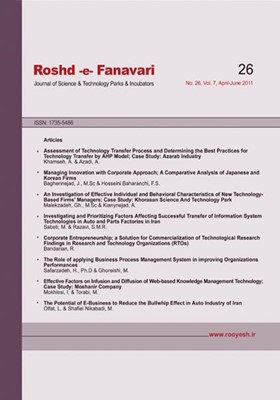-
-
List of Articles
-
Open Access Article
1 - Assessment of Technology Transfer Process and Determining the Best Practices for Technology Transfer by AHP Model; Case Study: Azarab Industry
Abbas Khamseh Azadeh Azadi -
Open Access Article
2 - Managing Innovation with Corporate Approach; A Comparative Analysis of Japanese and Korean Firms
Jafar Bagheri Nejad fahime sadaat Hoseini baharnarenji -
Open Access Article
3 - An Investigation of Effective Individual and Behavioral Characteristics of New Technology-Based Firms' Managers
Gholamreza Malekzadeh Azadeh Kiyani nejad -
Open Access Article
4 - Investigating and Prioritizing Factors Affecting Successful Transfer of Information System Technologies in Auto and Parts Factories in Iran
Mansoor Sabeti Seyed mohammadreza Razavi -
Open Access Article
5 - Corporate Entrepreneurship; a Solution for Commercialization of Technological Research Findings in Research and Technology Organizations (RTOs)
Reza Bandarian -
Open Access Article
6 - The Role of applying Business Process Management System in improving Organizations Performances
Hosein Safarzadeh Mausomeh Ghoreyshi -
Open Access Article
7 - Effective Factors on Infusion and Diffusion of Web-based Knowledge Management Technology; Case: Moshanir Company
Eman Mokhlesi Mostafa Torabi -
Open Access Article
8 - The Potential of E-Business to Reduce the Bullwhip Effect in Auto Industry of Iran
Lauya Olfat Mohsen Shafiei Nik Abadi
-
The rights to this website are owned by the Raimag Press Management System.
Copyright © 2017-2025







